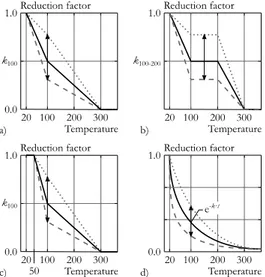ISBN: 978-91-88898-64-7
37
Simplified mechanical models for timber connections in fire
Pedro Palma †*, Jonas Wydler †‡, and René Steiger †
† Empa – Swiss Federal Laboratories for Materials Science and Technology, *pedro.palma@empa.ch
‡ ETH Zürich, Institute of Structural Engineering
Only few numerical models have been developed to study the fire behaviour of timber connections, even though experimental studies are also difficult to perform. Two main approaches have been followed: 3-D thermal finite-element (FE) models combined with simplified numerical mechanical models of single fasteners; and 3-D thermal-mechanical FE models. In the first approach, a 3-D heat transfer FE analysis is performed to determine the temperature fields in the connection and a simplified mechanical model is then used to estimate the mechanical behaviour at each time step. An advantage of this approach is that, since no 3-D FE stress analysis is performed, the overall number of model parameters, including the assumptions about their temperature dependency, is immensely reduced. In addition, simplified models can be very informative and allow assessing which parameters are relevant to describe selected aspects of the connections’ mechanical behaviour under fire. Since they are also much faster, they allow studying how sensitive these parameters are to various temperature-dependency models.
The proposed paper presents the results of a study on the influence of various temperature-dependency models (Figure 1) on two simplified mechanical models for timber connections in fire, namely based on Johansen’s yield models [1] and beam-on-elastic-foundation models [2] (Figure 2). The complexity of the load-carrying model should be adjusted to each specific study: Johansen-type models are very simple and adequate to estimate the load-carrying capacity, but do not take directly into account load redistribution between fasteners, which might be very important in some situations; beam-on-springs models allow accounting for load redistribution between fasteners and establish a time-displacement curve, as well as assessing the stiffness of the connection, but require more temperature-dependent parameters that also have to be calibrated (stiffness and resistance of the springs). Nevertheless, even though both modelling approaches rely on very few parameters, they are able to capture the load-carrying capacity after a given period of fire exposure, in the case of Johansen’s yield models, and the time-displacement behaviour, in the case of the beam-on-springs models (Figure 3). The study revealed that some of the temperature-reduction factor relationships do not seem to influence the mechanical behaviour of the connections (e.g. plateau between 20 and 50 °C), whereas others have a significant influence (e.g. residual load-carrying capacity above 300 °C).
Figure 1: Examples of single-parameter temperature-dependent reduction factors.
Figure 2: Beam-on-springs model: a) single fastener of a steel-to-timber
connection; b) load- displacement behaviour of a spring.
Figure 3: Experimental and simulated displacements (beam-on-springs model
and two different spring stiffness-temperature relationships).
References
[1] P. Palma, A. Frangi, Modelling the fire resistance of steel-to-timber dowelled connections loaded perpendicularly to the grain, Fire Saf. J. (2017). doi:10.1016/j.firesaf.2017.12.001.
[2] P. Cachim, J.-M. Franssen, Numerical modelling of timber connections under fire loading using a component model, Fire Saf. J. 44 (2009) 840–853. doi:10.1016/j.firesaf.2009.03.013.
